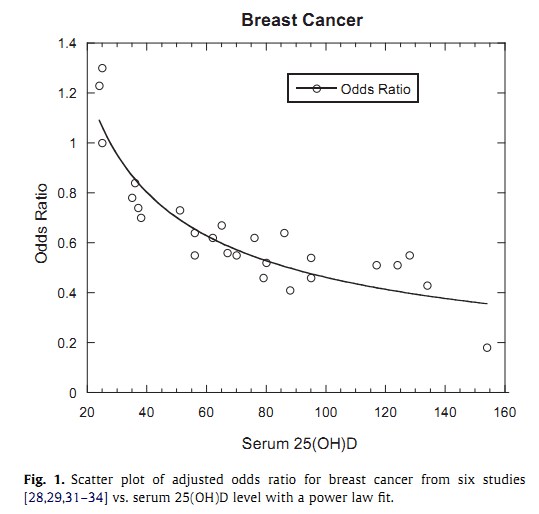Compelling evidence – Breast Cancer and vitamin D – Dissertation
Serum 25-hydroxyvitamin D and risk of breast cancer
by Mohr, Sharif Burgette, Ph.D., UNIVERSITY OF CALIFORNIA, SAN DIEGO, 2012, 134 pages
Globally, a wide range of epidemiological studies have linked low levels of sunlight, ultraviolet B (UVB) irradiance, or serum 25-hydroxyvitamin D [25(OH)], with increased risk of breast cancer.
Three studies of different design were employed to assess the relationship between serum 25(OH)D and breast cancer risk.
- The first study is an ecological analysis of the relationship between UVB irradiance and age-standardized breast cancer mortality rates worldwide.
- In the regression model, UVB irradiance was inversely associated with mortality rates (p = 0.04), after controlling for covariates.
- The overall model was statistically significant (R 2 = 0.34 , p < 0.0001).
- The second study was a case-control analysis of 600 incident cases of female breast cancer and their matched controls that investigated the inverse association between pre-diagnostic serum levels of 25(OH)D and risk of breast cancer in active-duty U.S. military personnel.
- Conditional logistic regression was used to assess the relationship between serum 25(OH)D concentration and breast cancer risk, while controlling for race and age.
- In this study, there was an inverse trend between serum 25(OH)D and odds of breast cancer that did not reach statistical significance .
- However, in 123 pairs for whom serum was collected 90 days or fewer before case diagnosis, women in the highest quintile of serum 25(OH)D had a 70% lower estimated risk of breast cancer (odds ratio 0.30, 95% confidence interval 0.12–0.74, p ? 0.01) compared to those in the lowest quintile.
- The third study was a pooled analysis of published data from 11 ordinary and nested case-control studies.
- Data from all 11 studies were combined in order to calculate the pooled odds ratio of the highest vs lowest quintile of 25(OH)D.
- The pooled odds ratio summarizing the estimated risk in the highest compared to the lowest quintile across all studies was 0.63 (95% confidence interval 0.47, 0.80).
These three studies provide compelling evidence that supports a strong inverse relationship between vitamin D status and breast cancer risk.
More studies, including randomized controlled trials of higher doses of vitamin D3 (4,000 IU–6,000 IU/day), and serum levels of 25(OH)D (60–80 ng/ml), should be performed without delay.
Advisers Cedric F. Garland; Deborah L. Wingard
School UNIVERSITY OF CALIFORNIA, SAN DIEGO
Source DAI/B 73-10, p. , Jun 2012
Source Type Dissertation
Subjects Epidemiology; Oncology
Publication Number 3509936
See also Vitamin D Life
Not enough women willing to stop taking vitamin D to permit breast cancer clinical trial – June 2012
6X less risk of death from Breast Cancer when vitamin D levels higher than 30 ng – May 2012
85 % less risk of death from Breast Cancer when vitamin D levels higher than 30 ng – May 2012
Worst breast cancer is 3X more frequent if less than 32 ng of vitamin D – March 2012
Breast Cancer Chemotherapy initially decreases vitamin D levels – May 2012
Cancer Treatment and Prevention UK May 2011 Grassroots on Breast Cancer
2X more likely to survive breast cancer disease free if lots of vitamin D – July 2011
Cloudiness and Breast Cancer PDF file
Need lots of UV AND vitamin D to reduce risk of breast cancer – Jan 2011
Breast Cancer vs latitude Gapminder - Great U shaped curve
No reduction in Breast Cancer if vitamin D was less than 40 ng - May 2011
Breast Cancer recurred more when less than 20 ng of vitamin D – Oct 2010
Breast cancer may result from poor interaction with vitamin D – Sept 2010 CYP27B1 and CYP24A1
Recurrence of breast cancer not associated with vitamin D levels – Jan 2011
Breast and other Cancer prevention - Dr. Wascher 2011 Blog and book
Breast Cancer vs vitamin D chart - 2010 chart follows

See also web
Meta-analysis of vitamin D, calcium and the prevention of breast cancer 2010
- 45% decrease in Breast Cancer for highest vs lowest vitamin D levels - without any vitamin D intervention!
- Not all types of Estrogen cause Breast Cancer July 2012
- Nice review, also mentions Vitamin D and Iodine deficiences
